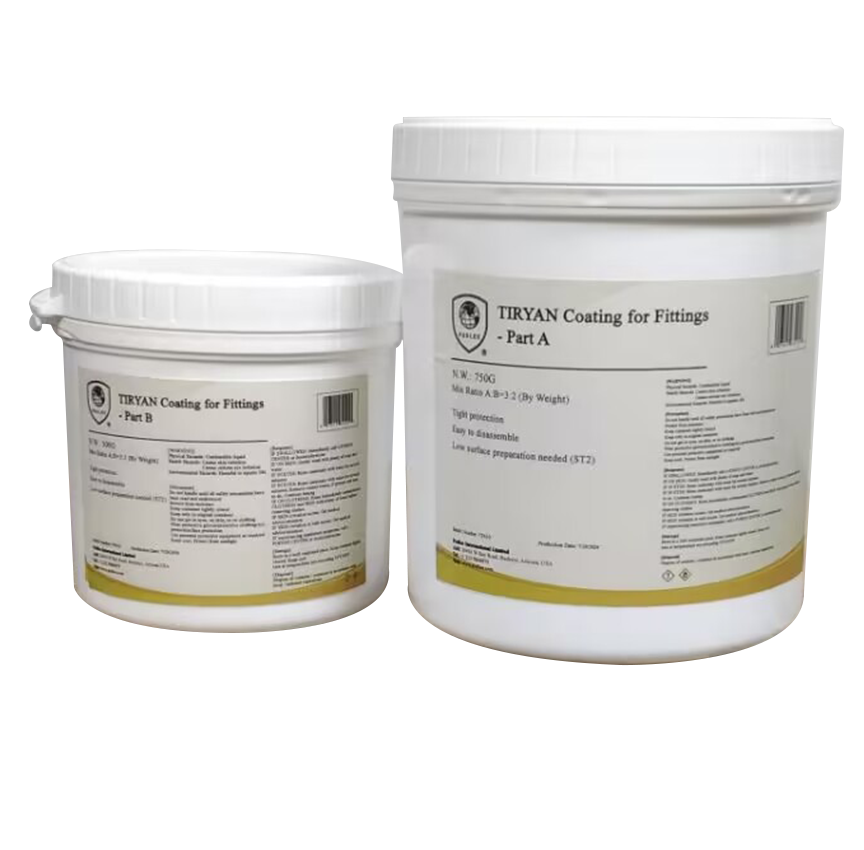
TIRYAN Coating
Tiryan is a revolutionary rubber-plastic coating developed by PodLee Laboratories in Arizona, USA. Its development began in early 2018 and spanned three and a half years.
The specially designed molecular structure of Tiryan provides excellent shear-thinning performance in its liquid state, along with optimal surface tension and nano-scale polymer size. This allows it to penetrate irregular gaps, such as bolt-nut interfaces and flange clearances, achieving dense, fully encapsulated coating.
ts unique formula and process enable natural curing at room temperature after application, forming a solid rubber-plastic isolation layer with outstanding properties: exceptional chemical and corrosion resistance, superior sealing performance, and damping characteristics.
Unlike traditional anti-corrosion coatings, Tiryan avoids issues like anchoring effects, high crosslink density, and rigid structures. It prevents "structural locking" between the coating and metal components, ensuring long-term protection while facilitating disassembly for maintenance. This makes it ideal for pipeline fittings.
Application
Anti-corrosion protection for pipeline joints (flanges, bolts, clamps, etc.)
Waterproofing and anti-corrosion protection for storage tank edge plates
Advantages
Strong Protection
Easy Disassembly
ST2 Low Surface Preparation
Typical Characteristics
| Item | Test Data | Testing Standards | |
|---|---|---|---|
| Cured Density (g/cc) | 1.6 | – | |
| Tensile Strength (psi/MPa) | 363/2.5 | ASTM D 638 | |
| Shore A Hardness | 70 | ASTM D2240 | |
| Elongation at Break (%) | 100% | ASTM D 638 | |
| Adhesion (psi/MPa) | Sandblasted Steel Plate | 870/6 | ASTM D4541 |
| Concrete | 290/2 | ||
| Rusted Steel Plate | 290/2 | ||
| FRP | 870/6 | ||
| Chemical Resistance (90 Days) | HCl (10%) | pass | ASTM G20 |
| NaOH (10%) | pass | ||
| NaCl (10%) | pass | ||
| Salt Spray Test (h) | 5000 | ASTM B117 | |
| Volume resistivity (Ω·m) | 1×1012 | ASTM D4496 | |
| Service Temperature (℉/℃) | -22/-30 – 94/90 | – | |
Packaging
1.25 KG/Kit, 6 Kits/CTN
Surface Preparation
Proper surface preparation is critical for optimal performance:
Degrease and desalinate surfaces. Rinse salt residues with freshwater in marine environments.
Remove contaminants and manually derust using wire brushes or sandpaper (ST2 grade).
Wipe surfaces clean with a dry cloth to remove moisture and loose rust.
Mixing
Ensure ambient temperature is 50 – 104℉ (10 – 40°C). When the ambient temperature is below 41℉ (5°C), Part A must be heated to above 50℉ (10°C).
Mixing ratio: 3:2 (By Weight). Total mix ≤ 400 g per batch.
Weigh components accurately and stir mechanically for 3 – 5 minutes.
Application
Apply using a brush or roller.
Single-coat thickness: 200 - 250 μm. For standalone use, apply ≥ 2 coats (total 400 - 500 μm).
Allow ≥ 18 hours between coats. If exceeding 72 hours, sand the prior coat before recoating.
Coverage
Based on a 250 μm thickness: 1 kg kit will cover 1.3 m2 (14 ft2)
Pot Life After Mixing
50℉ (10℃) – 40 min 70℉ (25℃) – 30 min 104℉ (40℃) – 20 min
Curing Schedule
| Temperature | 50℉ (10℃) | 70℉ (25℃) | 104℉ (40℃) |
|---|---|---|---|
| Surface Dry (h) | 8 | 4 | 3 |
| Complete Curing (h) | 36 | 24 | 18 |
Clean Up
Clean tools immediately after use with solvents (acetone, xylene, alcohol, etc.).
Storage
Store between 10°C (50°F) and 32°C (90°F).
Unopened product shelf life: 1 year.
Safety
Before using any products, review the appropriate Material Safety Data Sheet (MSDS) or Safety Sheet for your area. Follow standard confined space entry and work procedures, if appropriate.

